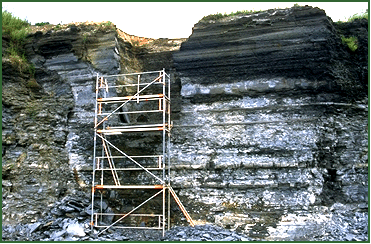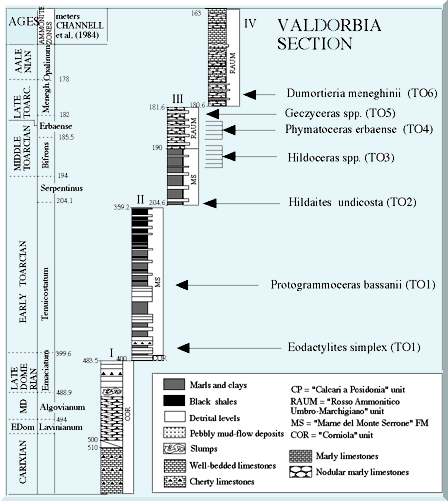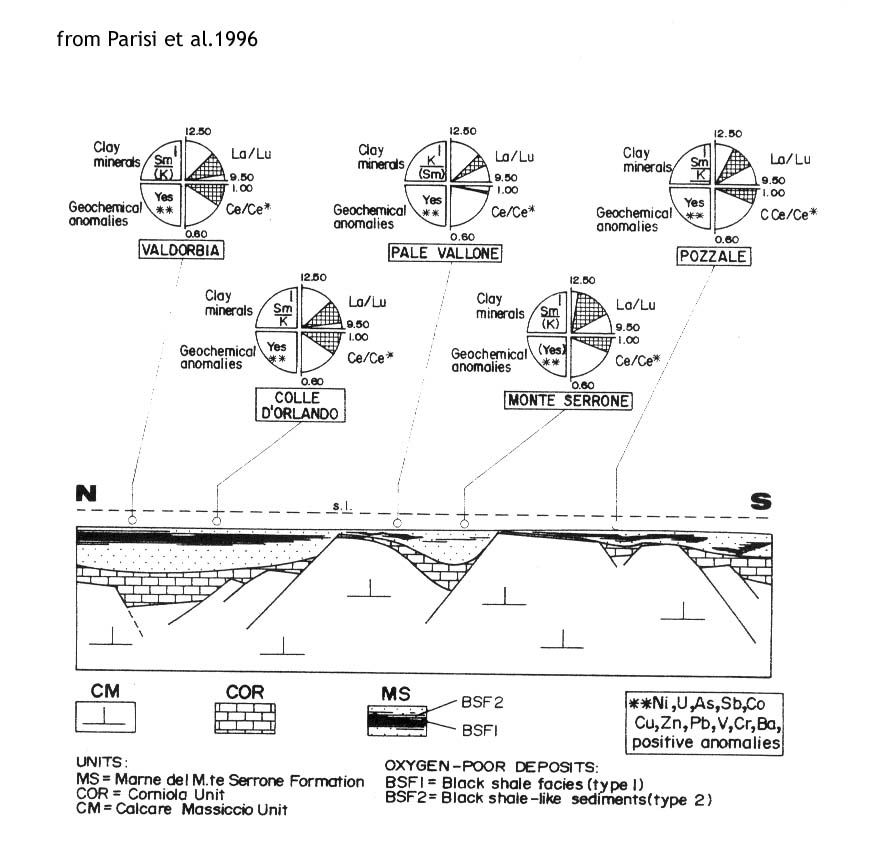2. LE FACIES ANOSSICHE DEL GIURASSICO INFERIORE NELL'APPENNINO CENTRALE
The organic-rich facies ("black shales") in the Early Jurassic: a case study from the central Apennines.
Parisi, G., Ortega-Huertas, M., Nocchi, M., Palomo, I., Monaco, P., and Martinez, F. (1996). Stratigraphy and geochemical anomalies of the early Toarcian oxygen-poor interval in the Umbria-Marche Apennines. Geobios, 29 (4), 469-484.
© and permission of all colour photographs, text and charts by P. Monaco
contribution: Miguel Ortega-Huertas and Inmaculada Palomo (Granada, Spain), Guido Parisi & Marisa Nocchi (Perugia)

Click to enlarge
Organic-rich intervals in ancient marine deposits, known as "black shales" in basins and shelves, were formed and largely investigated through geological record. During the Lower Jurassic (Early Toarcian), black shales are distributed wide in many sectors of Tethys, constituting the "Oceanic Anoxic Event " (OAE, see Jenkyns and Clayton, 1986; Jenkyns, 1988). Some authors believe that the Toarcian anoxic event was caused in the Tethys by several periods of biological crises that could span from the Domerian/Toarcian boundary to the top of the Serpentinus Zone. The preservation of organic matter can be explained by the concurrence of several factors, depending on the paleogeography, variation of sea-level, organic productivity, anoxia of the waters, tectonization of margins and degree of clay sedimentation, etc. (see extended literature reported in Baudin et al., 1990a,b; Monaco et al., 1994; Parisi et al., 1996).
Stratigraphy lab of Perugia has investigated this organic-rich interval in the Central Apennines (Umbria-Marche area, Valdorbia section Fig.2) in comparison with other parts of the Mediterranean realm (Spain, Germany, etc.). Oxygen-poor deposits of central Apennines involve multidisciplinary methodologies developed in many years, such as stratigraphy, sedimentology, micropaleontology and geochemistry (the latter with a collaboration of the University of Granada, see Monaco, et al., 1994; Ortega-Huertas, et al., 1993; Parisi, et al. 1996).
Results
Many stratigraphic section analyzed with "black shales" in the Umbria-Marche Apennines reveal two groups of facies that are directly related to basin morphology, on the base of macroscopic and microscopic observations. They are as follows: a) oxygenized deposits OF1 and OF2; b) poorly-oxygenized deposits (the typical "black shales" ) BSF1 and BSF2.
Intervalli ricchi in materia organica, assai conosciuti in antichi bacini marini come pacchi di strati o sottili intercalazioni di argilliti nere (i cosiddetti "black shales" della letteratura anglosassone), si svilupparono estesamente. Durante il Giurassico inferiore in molti settori della Tetide, tali depositi scuri costituivano,secondo alcuni autori, il cosiddetto "Evento anossico oceanico" (OAE vedi Jenkyns and Clayton, 1986; Jenkyns, 1988) del Toarciano (Fig.1). Alcuni autori pensano che l'evento anossico Toarciano fu causato da diversi periodi di crisi biologiche che partirono dal limite Domeriano/Toarciano per poi proseguire fino al top della Zona a Serpentinus. La preservazione della materia organica, per questo intervallo, può essere spiegata per una concomitanza di vari fattori, principalmente legati alla paleogeografia fortemente articolata della Tetide centrale durante il Giurassico inferiore, alle variazioni del livello marino su bacini articolati e poco profondi, alla abbondante produttività organica (e preservazione) e all'anossia estesa delle acque, alla tettonica dei margini e dei bacini adiacenti, al tenore della sedimentazione argillosa, eccetera (vedi l'estesa letteratura riportata in Baudin et al., 1990a,b; Monaco et al., 1994; Parisi et al., 1996).
Il laboratorio di Stratigrafia di Perugia sta studiando da diversi anni l'intervallo anossico nell'Appennino centrale (bacino Umbro-Marchigiano, Valdorbia Fig.2), confrontando i dati ottenuti con altre aree tetidee a facies di black shales o simili nel sud della Spagna, Grecia, Germania, area Mediterranea s.l., eccetera. Lo studio multidisciplinare dei depositi anossici toarciani è proseguito da diversi anni nei settori della stratigrafia, sedimentologia, tracce fossili e micropaleontologia, geochimica e mineralogia (quest'ultime in collaborazione con l'Università di Granada, Monaco, et al., 1994; Ortega-Huertas, et al., 1993; Parisi, et al. 1996).
Risultati
Gli studi mediante osservazioni macro e microscopiche e le correlazioni in una dozzina di sezioni studiate nell'Appennino Umbro-Marchigiano hanno rivelato due gruppi principali di facies: a) i depositi ossigenati OF1 e OF2; e b) i depositi scarsamente ossigenati BSF1 e BSF2 (le tipiche "black shales" della letteratura).


Click to enlarge
I. OF1Facies. These are constituted by white mudstones to wackestones, generally well stratified and moderately bioturbated with cherty lenses and by nodular, highly bioturbated mudstones to wackestones of reddish colour (Rosso Ammonitico unit). Abundant macrofauna of this last unit is represented by ammonites, echinoderm remains, and thin-shelled bivalves. Bioturbation is abundant and pervasive (both horizontal and vertical trace fossils are noted), displaying a diversified trace fossil association such as Chondrites, Planolites, Helminthopsis, Thalassinoides, Ophiomorpha, Skolithos, Paleophycus and Trypanites (Monaco, et al. 1994; 1995). Penetration depths, burrow diameters, traces fossils density and species diversity emphasize well oxygenated conditions both on the sea-bottom and in the sediment column.
II. OF2Facies. Theses facies are characterized by wackestones, mudstones and packstones varying in colour from violet to reddish and from green to light grey. These sediments are generally not laminated and show scattered nodules. Scarce macrofaunal content is given by thin-shelled bivalves and rare ammonites; foraminifers belong to an assemblage which is indicative of moderate oxygenation on the sea-floor (Nocchi, 1992). Trace fossils are scattered and not pervasive (Chondrites and Planolites).
The Total Organic Carbon (TOC) of OF1 and OF2 facies results very low (0 to 0.05 %). Pyrite is absent or scattered and positive geochemical anomalies are lacking indicating the absence of organic matter deposition (Monaco, et al., 1994).
b) Poorly-oxygenized facies (Black shales-like and black shales s.s.).
Oxygen-poor sediments are characterized by positive geochemical anomalies, by dark colour, by the presence of laminated sediments, in respect to underlying and overlying sediments. These deposits can be substantially subdivided into two different groups characterized as follow: III) "black shale facies" (BSF1) already well known in literature as typical black shales, and IV) "black shale-like sediments" (BSF2). The TOC value (total organic carbon) ranges generally from 0,5 to 2,7 % in both facies and maximum values are recorded in BSF1.
In all considered sections of Umbria-Marche area BSF2 facies precedes the BSF1 ones, evidencing as poorly-oxigenated conditions were formed gradually in the basin. After the maximum of anoxia, also the sea-bottom conditions turned gradually into normal conditions and oxygen content improved also whithin the substrate as evidenced by trace fossils. This has been shown also by geochemistry of organic matter and by phytoplankton and by the benthic foraminifer assemblage. The levels with maximum oxygen-poor conditions (some horizons of the BSF1 facies) present the lowest values of the La/Lu ratio among the Rare Earth Elements (REE) , showing values from 9.90 to 10.97 (Fig.3). Together with the greater intensity of the geochemical anomaly and the greater abundance of smectites (Fig.3) suggests that we should interpret these levels as having been deposited in more pelagic and perhaps even deeper marine conditions (see for a detailed description of these facies Parisi, et al., 1996).
I. Le OF1 sono rappresentate da marne argillose, marne calcaree e calcari ben stratificati, nodulari e bioturbati di colore rossastro (Rosso ammonitico, vedi Fig.2). Abbondante la macrofauna rappresentata da molte ammoniti, resti di echinodermi e bivalvi a guscio sottile. La bioturbazione è sempre abbondante e pervasiva (sia tracce fossili verticali che suborizzontali), costituita da: Chondrites, Planolites, Helminthopsis, Thalassinoides, Ophiomorpha, Skolithos, Paleophycus and Trypanites (Monaco, et al. 1994; 1995). La profondità di penetrazione, il diametro dei burrows, la diversità e densità delle tracce indica condizioni ben ossigenate sia del substrato sia delle acque di fondo.
II. Le OF2 sono costituite dalle medesime litologie sopraindicate, ma varianti in colorazione dal violetto al rossastro e dal verde al grigio. Questi sedimenti in genere sono non laminati e mostrano noduli scarsi. Il contenuto in macrofauna è scarso e formato soprattutto da bivalvi a guscio sottile e rare ammoniti. I microfossili indicano una moderata ossigenazione del fondo marino (Nocchi, 1992). Le tracce fossili sono scarse e mai pervasive, e si ritrovano Chondrites e piccoli Planolites.
Il contenuto totale di Carbone Organico delle facies OF1 e OF2 è molto basso (0-0.05%). La pirite è assente e le anomalie geochimiche positive sono assenti, indicando l'assenza o quasi di deposizione in materia organica (Monaco et al., 1994).
b) Le facies anossiche (tipo black shales e black shales s.s.).
Questi sedimenti sono in genere caretterizzati da anomalie geochimiche positive, dal colore in genere scuro, da laminazioni da decantazione (assenza di burrowing), rispetto ai depositi ben ossigenati. Le facies scarsamente ossigenate possono essere suddivise in due gruppi principali: III. facies black shales s.s. (BSF1), e IV. facies tipo black shales (BSF2). I valori del contenuto in materia organica (TOC) variano in genere tra 0.5 e 2.7% in entrambe le facies, ed il massimo valore è stato registrato nelle BSF1. Nelle successioni studiate dell'Appennino Umbro-Marchigiano le BSF2 precerdono le BSF1, evidenziando come le condizioni poco ossigenate si formavano nel Toarciano inferiore gradualmente nel bacino. Dopo un massimo di anossia verso la parte alta della Zona Tenuicostatum, anche le condizioni del fondo marino tornavano gradualmente in condizioni normali e l'ossigeno disciolto si disponeva anche entro il substrato come dimostrato dalle tracce fossili. L'incremento nell'ossigenazione è confermato dalla geochimica della materia organica, dal fitoplankton e dal benthos a foraminiferi. I livelli con i valori massimi di anossia entro le facies BSF1 presentano i valori minori del rapporto La/lu tre le terre rare (REE), con valori compresi tra 9.90 e 10.97 (Fig.3). Tali valori assieme alle maggiori anomalie geochimiche positive tra gli elementi in traccia e alle smectiti (Fig.3) suggeriscono una deposizione in ambienti più francamente pelagici e anche, probabilmente, più profondi (vedi per una descrizione dettagliata Parisi et al., 1996).
• BAUDIN F., HERBIN J. P., VANDERBROUCKE M. 1990A - Mapping and geochemical characterization of the Toarcian organic matter in the Mediterranean Tethys and Middle East. Advances in Organic Geochemistry 1989, Organic Geochemistry 16, (4-6), 677-687.
• BAUDIN F., HERBIN J. P., BASSOULET J. P., DERCOURT J., LACHKAR G., MANIVIT H., & RENARD M. 1990b - Distribution of organic matter during the Toarcian in the Mediterranean Tehys and Middle East. In HUC A. Y. (eds.), Deposition of Organic facies. AAPG, Studies in Geology, Tulsa, 73-91.
• JENKYNS H. C. 1988 - The early Toarcian (Jurassic) anoxic event: stratigraphic, sedimentary and geochemical evidence. American Journal of Science, 288, 101-151.
• JENKYNS H. C., & CLAYTON C. 1986 - Black shale and carbon isotope in pelagic sediments from the Tethyan lower Jurassic. Sedimentology, 33, 87-106.
• NOCCHI M. 1992 - Associazioni a foraminiferi bentonici del Bacino Umbro-Marchigiano (Appennino centrale) durante il Lias. Paleopelagos, 2, 37-53.
• ORTEGA-HUERTAS M., MONACO P. & PALOMO I. (1993) - First data on clay mineral assemblages and geochemical characteristics of Toarcian sedimentation in the Umbria-Marche basin (central Italy ). Clay Minerals, 28: 297-310.
• MONACO P., NOCCHI M., ORTEGA-HUERTAS M., PALOMO I., MARTINEZ F., & CHIAVINI G. 1994 - Depositional trends in the Valdorbia section (Central Italy) during the Early Jurassic, as revealed by micropaleontology, sedimentology and geochemistry. Eclogae geologicae Helvetiae, 87 (1), 157-223.
• MONACO P. (1995): Relationships between trace-fossil communities and substrate characteristics in some Jurassic pelagic deposits in the Umbria-Marche basin, Central Italy. Geobios, M.S., 18: 299-311.
• PARISI G., ORTEGA-HUERTAS M., NOCCHI M., PALOMO I., MONACO P., and MARTINEZ F. (1996). Stratigraphy and geochemical anomalies of the early Toarcian oxygen-poor interval in the Umbria-Marche Apennines. Geobios, 29(4), 469-484.